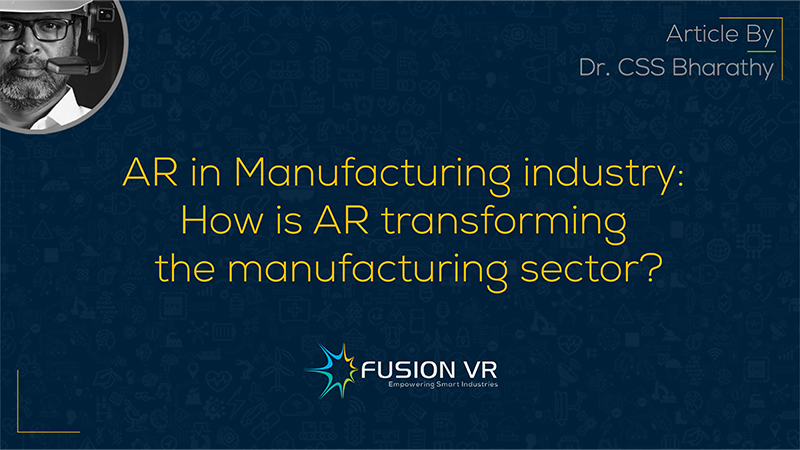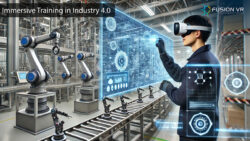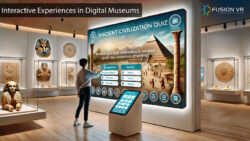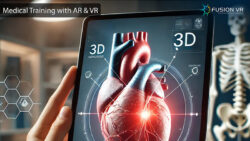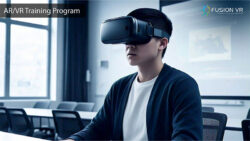Augmented Reality in the manufacturing industry is no small topic! Trust me.
You may not believe this, but it was one of the topics presented and discussed in May this year at the World Economic Forum in Davos, Switzerland. They discussed how the next-generation workforce in the manufacturing industry could be empowered using AR innovation. It’s quite exciting that the world’s top economic and political leaders are discussing how this marvellous technology can be used to benefit the manufacturing industry.
Augmented reality for manufacturing has made great strides in various industries and sectors of the global economy. Market experts across the world estimate the growth potential of both Augmented Reality and Virtual Reality together, and it’s quite common to find the expected market value for both these technologies combined in publications and websites. Bloomberg reported in June 2022 that the AR and VR market is expected to reach 454.73 billion dollars by 2030 with a 40.7% CAGR. While such projections may vary across different publications and research entities, it is widely and unanimously acknowledged that the potential to exploit and derive competitive advantage is significant for manufacturing companies worldwide.
There are many of you who would have already heard about or experienced AR in the past few years, but please allow me to present a few facts on augmented reality for the wider general audience.
AR Training for Manufacturing Employees: Importance and Impact
First and foremost, AR is a safe and easy-to-use technology. AR applications can be used with your smartphone or tablet, such as an iPad or Tab. There are also specially designed AR goggles such as Magic Leap, Microsoft Hololens and many others in the market to experience it. The technology allows you to overlay digital content on the surrounding reality that you see using your device’s camera. This information enhances and supports what you see with contextual and relevant information that elevates your normal experience or assists you with anything that you would need in real-time in the activity you are engaged in. Now that we have an idea of what AR is let us get to what it can do for manufacturing companies.
Manufacturing companies will be the biggest beneficiaries of AR as it enables them to train, guide, monitor and enhance the performance and productivity of their workforce. AR implementation leads to positive changes in safety, quality, output etc. and delivers increased productivity, excellent employee engagement, world-class quality and lower operating costs. This is relevant considering the changes brought about by the COVID-19 pandemic and the need to ensure continuity and safety in managing operations. AR will also contribute towards addressing the anticipated shortages in the labour pool and experienced manufacturing professionals. A few use cases will help to illustrate how the adoption of AR in the manufacturing industry is transforming companies. Let’s begin with training.
Training employees is an important activity in any manufacturing company. This is essential for both newcomers and existing employees. Most of the training imparted is usually mandatory, and it depends on the job type of the employee and the required skill sets. Such training could be compliance training or work-related training that is instructor-led or computer-based. Most training modules come with an evaluation that certifies proper completion of such training. The training is also delivered is required periodically in order for the employee to retain the certification that is necessary for continued employment. It’s worth emphasising that frequent injuries, breakdowns and quality complaints are directly related to a lack of proper training.
How do we do training with AR, then? In this use case, assume an employee needs to be trained on a piece of machinery that he or she is required to operate and the AR solution loaded on a tablet. The trainee would be able to view the machinery through the tablet, which opens a guided training module that provides details on its main parts, its operating principle, controls, its start-up and shutdown, troubleshooting techniques etc. This happens on the actual equipment and not on a drawing or model of it. The trainee moves through each module and gets evaluated for knowledge, understanding and accuracy. This training can be repeated until the required standards are met and to the satisfaction of the trainer. The entire training can be supervised, and a detailed report can be emailed for the trainee to review. All results can be integrated into the organisation’s learning management system.
The benefits of the training use case are less dependence on the training coach or supervisor, guided and repetitive training until competency is achieved, direct feedback with opportunities for improvement, higher engagement, and increased knowledge retention and confidence. This is particularly useful for large manufacturing organisations with expansive training programs in sectors such as oil and gas, petrochemicals, power, utilities, semiconductors, pharmaceuticals, automotive, mining etc. This training solution also delivers value for medium and small manufacturing (MSME) enterprises which cannot employ a significant number of trainers as they usually have a smaller workforce. This use case enables the digitalisation of a key function in the organisation and enables the utilisation of human resources more effectively.
Human error is fairly common, but the price it extracts is often very high. We have seen that human error and negligence lead to serious injuries, downtime, and regulatory fines and invite greater scrutiny from statutory bodies. Avoiding human error keeps the workforce safe, increases productivity ensures quality, reduces downtime, saves costs and boosts ROI. AR provides assistance to operators, technicians and engineers with the necessary guidance and oversight to perform their tasks safely and accurately. It helps them develop safe operating behaviours and high operational discipline. Using instructions in the Standard Operating Procedures, a wearable or mounted AR device provides instructions, cautionary messages and quality control data at the point of the activity that eliminates human error. These timely assists are tremendously useful as human beings have a tendency to get distracted and preoccupied with what is happening around them or in their own lives. The use of augmented reality in car manufacturing is already a reality. Refineries and chemical companies are actively seeking solutions that will help with training and remote support. AR is coming of age and is proving to be a fantastic technology that enhances human performance.
In the world of maintenance and troubleshooting, AR has become a powerful tool. When operating plants shut down because of machinery issues, it needs to be rectified and restored to normal operation as soon as possible. The importance of this cannot be overstated as there is a lost profit opportunity due to loss of production. Customers who await these products could be affected and this leads to further supply chain issues downstream. It is therefore imperative that the machinery is fixed quickly. Such machinery is often quite complex and diagnosing the fault and its rectification could take considerable time.
AR solutions devised by OEMs and maintenance experts skillfully guide plant technicians and engineers to take a step-by-step approach to uncover the issues and also help rectify them in a way that avoids rework. Remote assistance is also provided by any expert from any corner of the globe. This is happening at multiple organisations around the globe, where the traditional approach has been completely transformed. AR is helping companies restore plants back to production safely and quickly. Such AR solutions are also climate-friendly. Manufacturing experts who are in different corners of the world need not travel extensively to deliver the support needed. Air travel, as you know, is a huge contributor to global CO2 emissions and reducing the necessity for travel with innovative solutions will help companies contribute to addressing climate change. Companies have begun to recognise the larger role they can play and need to actively work with OEMs and ensure AR solutions are integrated as part of their supply and thereby saving time and money for operating companies.
AR is truly transforming manufacturing as the technology is more accessible and quicker to implement. This is a key Industry 4.0 technology that is revolutionising the manufacturing landscape. The devices that power AR technology are growing at a tremendous pace, keeping in line with the wide-ranging needs of the manufacturing industry.
As manufacturing moves to low-cost countries, the competitive manufacturing landscape has become tougher. Companies need to innovate their manufacturing processes with the increased use of technologies like Augmented Reality for manufacturing. The technological advancement achieved through increased digitalisation of the manufacturing spectrum will deliver a crucial competitive advantage to these organisations. Quality, better customer service and supply chain efficiencies are going to help retain customers in these competitive times.
CEOs and CTOs need to engage experienced solutions providers who have the digital expertise and the manufacturing domain expertise to curate solutions for them. This will help achieve efficiencies and create new business models for the future. We at Fusion VR have the subject matter expertise and the advanced skills to assist you in your efforts to get digitally connected and achieve manufacturing excellence using augmented reality. Reach out to my team or me ASAP!

